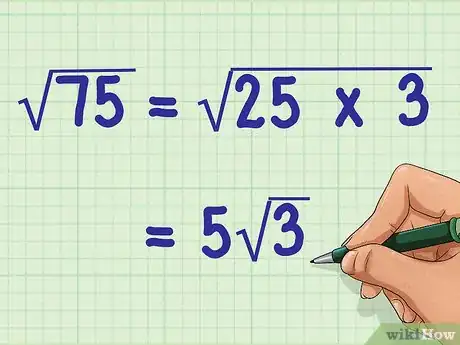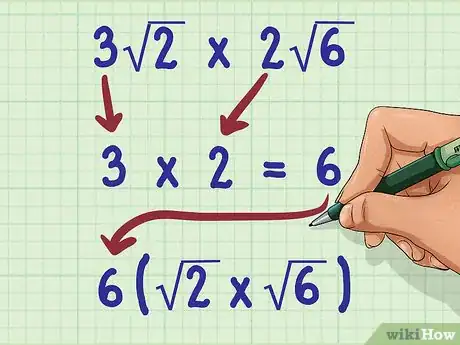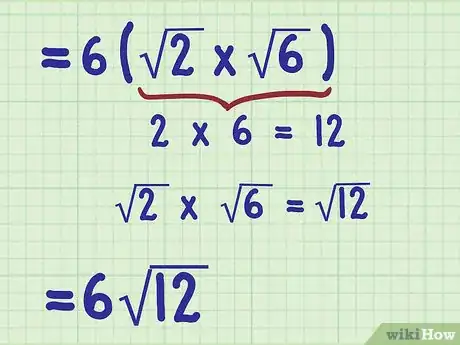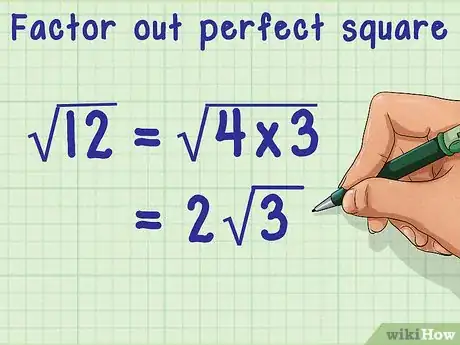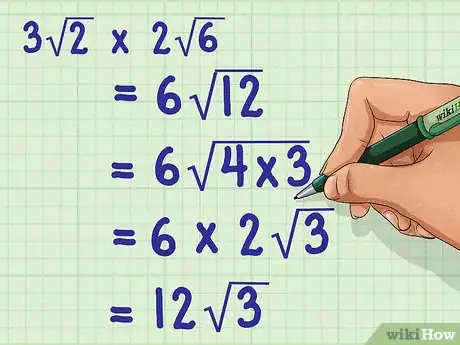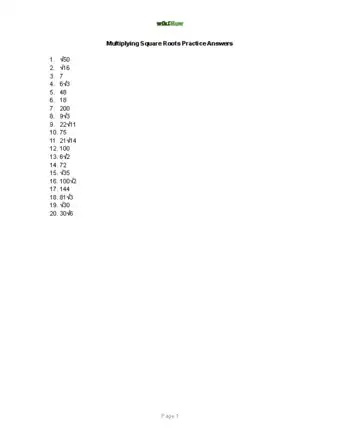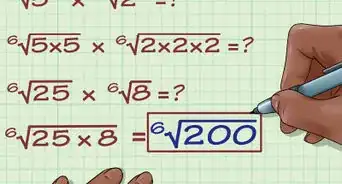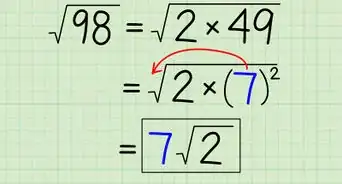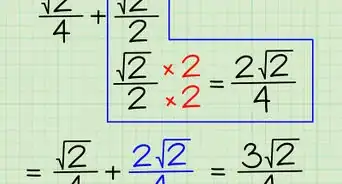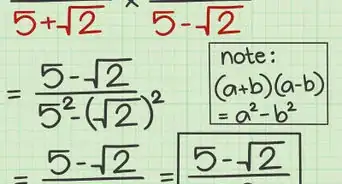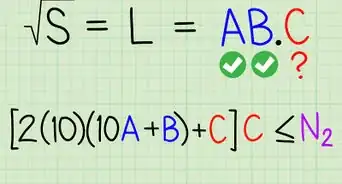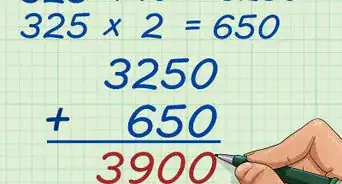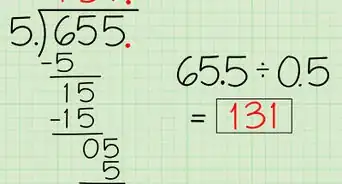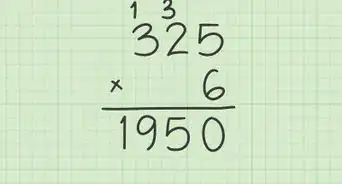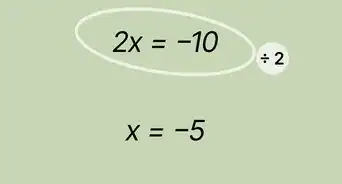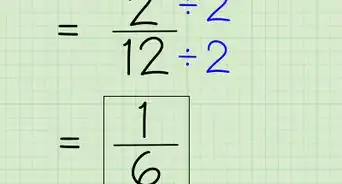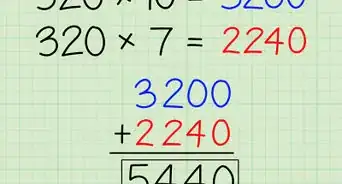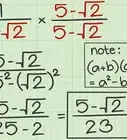This article was co-authored by David Jia. David Jia is an Academic Tutor and the Founder of LA Math Tutoring, a private tutoring company based in Los Angeles, California. With over 10 years of teaching experience, David works with students of all ages and grades in various subjects, as well as college admissions counseling and test preparation for the SAT, ACT, ISEE, and more. After attaining a perfect 800 math score and a 690 English score on the SAT, David was awarded the Dickinson Scholarship from the University of Miami, where he graduated with a Bachelor’s degree in Business Administration. Additionally, David has worked as an instructor for online videos for textbook companies such as Larson Texts, Big Ideas Learning, and Big Ideas Math.
There are 7 references cited in this article, which can be found at the bottom of the page.
This article has been viewed 1,420,468 times.
You can multiply square roots, a type of radical expression, just as you might multiply whole numbers. Sometimes square roots have coefficients (an integer in front of the radical sign), but this only adds a step to the multiplication and does not change the process. The trickiest part of multiplying square roots is simplifying the expression to reach your final answer, but even this step is easy if you know your perfect squares.
Steps
Multiplying Square Roots Without Coefficients
-
1
-
2Factor out any perfect squares in the radicand. To do this, see whether any perfect square is a factor of the radicand.[3] If you cannot factor out a perfect square, your answer is already simplified and you need not do anything further.
- A perfect square is the result of multiplying an integer (a positive or negative whole number) by itself.[4] For example, 25 is a perfect square, because .
- For example, can be factored to pull out the perfect square 25:
=
Advertisement -
3Place the square root of the perfect square in front of the radical sign. Keep the other factor under the radical sign. This will give you your simplified expression.[5]
- For example, can be factored as , so you would pull out the square root of 25 (which is 5):
=
=
- For example, can be factored as , so you would pull out the square root of 25 (which is 5):
-
4Square a square root. In some instances, you will need to multiply a square root by itself. Squaring a number and taking the square root of a number are opposite operations; thus, they undo each other. The result of squaring a square root, then, is simply the number under the radical sign.[6]
- For example, . You get that result because .
Multiplying Square Roots With Coefficients
-
1Multiply the coefficients. A coefficient is a number in front of the radical sign. To do this, just ignore the radical sign and radicand, and multiply the two whole numbers. Place their product in front of the first radical sign.
- Pay attention to positive and negative signs when multiplying coefficients. Don't forget that a negative times a positive is a negative, and a negative times a negative is a positive.
- For example, if you are calculating , you would first calculate . So now your problem is .
-
2Multiply the radicands. To do this, multiply the numbers as if they were whole numbers. Make sure to keep the product under the radical sign.[7]
- For example, if the problem is now , to find the product of the radicands, you would calculate , so . The problem now becomes .
-
3Factor out any perfect squares in the radicand, if possible. You need to do this to simplify your answer.[8] If you cannot pull out a perfect square, your answer is already simplified and you can skip this step.
- A perfect square is the result of multiplying an integer (a positive or negative whole number) by itself.[9] For example, 4 is a perfect square, because .
- For example, can be factored to pull out the perfect square 4:
=
-
4Multiply the square root of the perfect square by the coefficient. Keep the other factor under the radicand. This will give you your simplified expression.[10]
- For example, can be factored as , so you would pull out the square root of 4 (which is 2) and multiply it by 6:
=
=
=
- For example, can be factored as , so you would pull out the square root of 4 (which is 2) and multiply it by 6:
Calculator, Practice Problems, and Answers
Community Q&A
-
QuestionWe are not allowed to use a calculator, so how do I multiply a whole number by a square root?
 Community AnswerWhen you multiply a whole number by a square root, you just put the two together, with the whole number in front of the square root. For example, 2 * (square root of 3) = 2(square root of 3). If the square root has a whole number in front of it, multiply the whole numbers together. So 2 * 4(square root of 3) = 8(square root of 3).
Community AnswerWhen you multiply a whole number by a square root, you just put the two together, with the whole number in front of the square root. For example, 2 * (square root of 3) = 2(square root of 3). If the square root has a whole number in front of it, multiply the whole numbers together. So 2 * 4(square root of 3) = 8(square root of 3). -
QuestionWhat is 2 root 3 times root 3?
 DonaganTop Answerer√3 times √3 equals 3. Two times that is 6.
DonaganTop Answerer√3 times √3 equals 3. Two times that is 6. -
QuestionWhat is 4 divided by square root of 5?
 Community Answer(4√5)/5. Since radicals are not supposed to be in the denominator, you multiply by √5/√5 to get (4√5)/5.
Community Answer(4√5)/5. Since radicals are not supposed to be in the denominator, you multiply by √5/√5 to get (4√5)/5.
Things You'll Need
- Pencil
- Paper
- Calculator
References
- ↑ https://www.mathsisfun.com/definitions/radicand.html
- ↑ http://www.virtualnerd.com/pre-algebra/real-numbers-right-triangles/squares-square-roots/square-root-examples/multiplication-example
- ↑ https://www.wtamu.edu/academic/anns/mps/math/mathlab/int_algebra/int_alg_tut41_rationalize.htm
- ↑ http://www.mathwarehouse.com/arithmetic/numbers/what-is-a-perfect-square.php
- ↑ https://www.prodigygame.com/in-en/blog/multiplying-square-roots/
- ↑ http://www.virtualnerd.com/algebra-1/algebra-foundations/squaring-square-roots.php
- ↑ https://www.wtamu.edu/academic/anns/mps/math/mathlab/int_algebra/int_alg_tut41_rationalize.htm
- ↑ https://math.libretexts.org/Courses/Monroe_Community_College/MTH_165_College_Algebra_MTH_175_Precalculus/00%3A_Preliminary_Topics_for_College_Algebra/0.03%3A_Review_-_Radicals_(Square_Roots)
- ↑ http://www.mathwarehouse.com/arithmetic/numbers/what-is-a-perfect-square.php
About This Article
To multiply square roots, first multiply the radicands, or the numbers underneath the radical sign. If there are any coefficients in front of the radical sign, multiply them together as well. Finally, if the new radicand can be divided out by a perfect square, factor out this perfect square and simplify it. If you want to learn how to check your answers when you're finished solving, keep reading the article!








